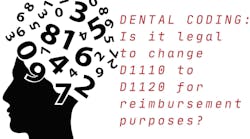Changing D1110 to D1120 for reimbursement purposes: Is this legal?
Listen to this article on our podcast!
Question: Why does our office insurance coordinator change the code D1110 (adult prophy) to D1120 (child prophy) when the patient has all permanent teeth? Per the ADA procedure codes, I was taught that the correct code to use is based on the dentition type (primary, transitional, or permanent). What do I do?
Answer: Never change the procedure code to receive reimbursement from an insurance carrier! The CDT 2024 Coding Companion states, “Treatment plans must be developed according to professional standards, not according to provisions of the dental benefit contract.”
In August 2000, the federal government designated the ADA (under HIPAA) to create the CDT as the national terminology for reporting dental services. Along with that came the responsibility to maintain the codes, which is handled by the Code Maintenance Committee (CMC) of the Council on Dental Benefits Programs. The committee meets yearly to discuss edits, amendments, or the creation of new procedure codes. All dental providers are expected to select the appropriate procedure code based on the descriptors for those codes.
The problem
The dental software programs provide only the code number and nomenclature (title) but not the descriptor. Descriptors change yearly. More than 200 changes have been made since 2020. You are correct that the descriptors for adult and child prophy are “dentition specific.” (CDT 2024, p. 13)
D1110: Removal of plaque, calculus, and stains from the tooth structures and implants in the permanent and transitional dentition. It is intended to control local irritational factors.
D1120: Removal of plaque, calculus, and stains from the tooth structures and implants in the primary and transitional dentition. It is intended to control local irritational factors.
These code descriptors read the same except for the type of dentition, and both codes mention transitional dentition. Transitional includes a mix of primary and permanent teeth. This seems confusing. Why would they include transitional in the adult prophy descriptor if they want us to use the code based on dentition and not age?
They know that many insurance carriers have restrictions in their contracts that limit available benefits or base the benefits on age and not dentition. The carriers are aware of the descriptors, but they are not required to adhere to them. For example, most of the Delta Dental plans use age 14 to differentiate between an adult and child. Some carriers use 12, 13, or 15, and others use no age definition at all. To further complicate things, the ADA House of Delegates passed two resolutions addressing the age issue in their policy “Age of Child” (1991:635). Here’s how it reads:
“Resolved, that when dental plans differentiate coverage of specific procedure based on the child or adult status of the patient, this determination be based on the clinical development of the patient’s dentition, and it be further resolved that where administrative constraints of a dental plan preclude the use of clinical development so that chronological age must be used to determine child or adult status, the plan defines a patient as an adult beginning at the age 12 with the exclusion of treatment for orthodontics and sealants.”
In other words, in 1991 the ADA stated that the clinical development of the patient’s dentition should be used. However, if a particular plan must have age constraints, 12 should be used as the beginning age of an adult except in cases of consideration for orthodontics and sealants. But we still have many carriers who don’t abide by this resolution.
The solution
All insurance companies should use the same rules for all plans and make this an easy process for everyone. Of course, this isn’t the case. What can we do about it?
Page 85 of the CDT 2024 Coding Companion states, “Prophylaxis claims may be rejected by third-party carriers as not meeting plan age specification for this service. It is appropriate to appeal such claim rejection. It is not appropriate for a dental benefit plan to ask that the claim be resubmitted with a different prophylaxis code solely for reimbursement.”
For plans with contractual limits based on age instead of dentition, the insurance company often automatically changes or remaps the submitted code once the claim is submitted. This could mean changing a D1110 adult prophy to a D1120 child prophy and reimbursing less than originally expected. Alternatively, they can change a submitted D1120 child prophy to a D1110 adult prophy but still provide reimbursement only for the dollar amount originally submitted for the D1120.
Remember that the insurance company can change submitted codes based on the limits of the plan, but the office can never change the code simply to obtain a different reimbursement. As an attempt to receive the correct reimbursement based on the ADA descriptors, some offices include a narrative in Box 35 of the ADA claim form stating that they are adhering to the ADA code descriptors to describe the patient’s dentition. After payment is made the office can either accept these changes as payment in full or attempt an appeal for full reimbursement if the dentist deems it appropriate, referring to the CDT 2024 code descriptors.
See the letter at the end of this article as a sample that can be used to alert parents about this issue and how it may affect their accounts.
Offices usually don’t pass this difference on to parents, but they must be advised that this may occur. If a parent is frustrated by the payment from the insurance company, the office can recommend they submit this letter along with any other documentation the office can provide, and to consult with their employer benefits manager. Their insurance plan is merely a contract between the employer and insurance company. The benefits manager holds far more clout to get the age criteria changed. They may be more inclined to negotiate on behalf of the employees if they have proof of the ADA’s guidelines provided.
Why should you be concerned?
Dental hygienists are under the same scrutiny as dentists and may be subject to disciplinary action if they do not submit the appropriate CDT procedure codes. Most state practice acts have provisions relating to grounds for disciplinary action that could put their license in jeopardy.
In the ADA’s Principles of Ethics and Code of Professional Conduct, Section 5—Principles: Veracity (truthfulness), it states: The dentist has a duty to communicate truthfully.
“5.b.5 Dental procedures. A dentist who incorrectly describes on a third-party claim form a dental procedure in order to receive a greater payment or reimbursement or incorrectly makes a noncovered procedure appear to be a covered procedure on such a claim form is engaged in making an unethical, false, or misleading representation to such third party.”
If you’re asked to select a procedure code whose descriptor doesn’t fit the patient’s oral condition, let your dentist and insurance coordinator know that you will not do this. You can remind them of the Code of Ethics and Professional Conduct and of the Code of Conduct provisions in your state. Submitting the improper code to gain reimbursement could also be considered a fraudulent act.
The bottom line is that there isn’t an easy solution except for all of us to adhere to the ADA’s Golden Rule when it comes to dental procedural coding: “Code for what you do and do what you code.”
Editor's note: This article appeared in the April/May 2024 print edition of RDH magazine. Dental hygienists in North America are eligible for a complimentary print subscription. Sign up here.
Kathy S. Forbes, BS, RDH, has been a dental hygienist, educator, speaker, author, consultant, seminar, and study club leader for more than 40 years. She holds a license with the ADA for Current Dental Terminology, which allows her to provide the most up-to-date understanding of current procedure codes. Kathy currently serves as a director for the Dental Codeology Consortium, reviewing and developing procedure codes relevant to dental hygiene practice that are presented to the Code Maintenance Committee of the American Dental Association in March each year.
Connie Simmons, MA, BSDH, RDH, earned her BSDH from The Ohio State University and her MA in aging studies from Wichita State University. She’s worked in clinical hygiene for almost 35 years and has other roles in clinical training, sales, speaking, and writing. Her knowledge of dental insurance and coding grew while working with an insurance carrier, and she’s now part of the Dental Codeology Consortium and an associate productivity coach with Inspired Hygiene. She’s also an expert in the clinical use of silver diamine fluoride. Reach her at [email protected].
(Sample narrative for parents describing child prophy versus adult prophy)
BILLING NOTIFICATION FOR PARENTS
WITH CHILDREN UNDER THE AGE OF 14
Your child’s dentition (teeth present in the mouth now) does not qualify for the procedure code that we have been using in the past. We are mandated by HIPAA (the federal government) to submit procedure codes developed by the American Dental Association. The descriptors of the procedures are based on the dentition of the child, not the age. Unfortunately, some insurance carriers have created contract limitations, IN DIRECT CONFLICT WITH THE FEDERAL MANDATE, and limit your benefits based on age.
The procedure code descriptors are:
Prophylaxis – Adult (D1110): Removal of plaque, calculus, and stains from the tooth structures and implants in the permanent and transitional dentition. It is intended to control local irritational factors.
Prophylaxis – Child (D1120): Removal of plaque, calculus, and stains from the tooth structures and implants in the primary and transitional dentition. It is intended to control local irritational factors.
Transitional dentition is when there is a mix of primary teeth and permanent teeth. This time typically begins with the appearance of the permanent first molars (around age 6) and ends with the exfoliation (falling out) of the last primary tooth (around ages 12-14). Since children lose teeth at different rates, the time for this transition varies.
Determination of whether your child is a “transitional” adult or child will depend on the health of the mouth, the amount of time necessary to perform the procedure, working with the child (and parent) demonstrating and practicing toothbrushing, flossing, etc., and answering any questions either may have.
Although all insurance carriers are aware of these descriptors, they may have written contract limitations based on age rather than the required dentition. When we submit your claim, we will send the following notice to help expedite the benefits from your carrier.
Billing of adult prophylaxis is based on the current CDT procedure code descriptors: Adult dentition as transitional and permanent dentition and child dentition as transitional and primary dentition. If benefits are unavailable for Prophylaxis – Adult due to contract limitations, please consider an alternate benefit of Prophylaxis – Child.
In the event your insurance carrier will not provide the benefits you are used to receiving, you may be responsible for the balance. We will do everything in our power to assist you in processing this claim.
We will not be able to submit an adult prophylaxis as a child prophylaxis to satisfy any age limit constraints of your plan. This would put our practice in legal jeopardy and in a position of willfully committing insurance fraud. Your understanding of this situation is much appreciated!
Narrative updated 02/2024










